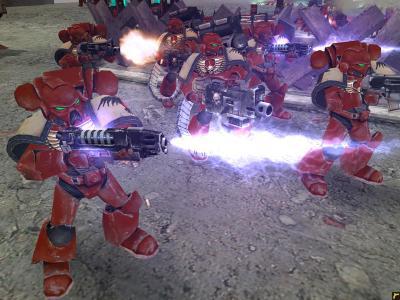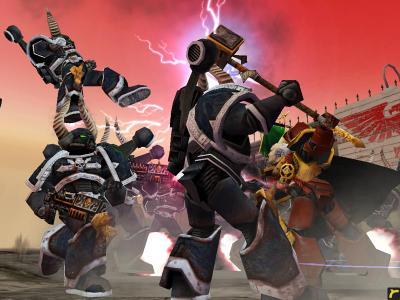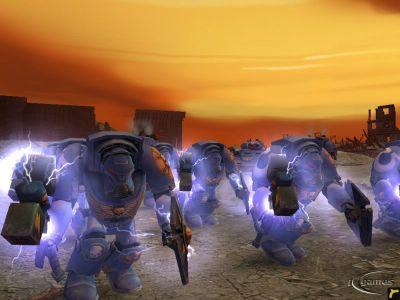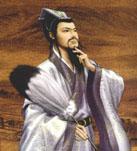 It's hard to imagine more obvious RTS material than Warhammer 40,000, but fans had to wait over a decade after the genre came of age for a developer with the guts, gold and Games Workshop support to pull it off. Relic Entertainment has marketed Dawn of War as an industry-defining game that focuses on 'visceral frontline combat', a phrase that appears six times on the game's FAQ page. Unlike traditional RTS, which allegedly revolves round attacking the enemy's supply lines (his 'peons', in case you're not sure which competition Relic's referring to), DOW keeps play at the sharp end through an economy based on controlling 'strategic points' and combat squads that can be reinforced where they stand (by teleportation).
It's hard to imagine more obvious RTS material than Warhammer 40,000, but fans had to wait over a decade after the genre came of age for a developer with the guts, gold and Games Workshop support to pull it off. Relic Entertainment has marketed Dawn of War as an industry-defining game that focuses on 'visceral frontline combat', a phrase that appears six times on the game's FAQ page. Unlike traditional RTS, which allegedly revolves round attacking the enemy's supply lines (his 'peons', in case you're not sure which competition Relic's referring to), DOW keeps play at the sharp end through an economy based on controlling 'strategic points' and combat squads that can be reinforced where they stand (by teleportation).DOW certainly delivers unprecdented unit animation, and atmospherics normally reserved for FPS heavies like Medal of Honor - the screen shakes, combatants yell out randomly, explosions send bodies and terrain flying, etc. Most impresive for an RTS are the hundreds of combat animations, including unit-specific kill sequences that are the most shameless pandering to bloodlust I've ever seen in a computer game (then again, it is Warhammer). By Relic's own admission the camera zoom has no gameplay function, being designed entirely to let you enjoy the carnage up close or from any angle of the compass.
Add a gothic soundtrack, and it really does feel like you're in the 40K universe. A universe of battle.

Captain Angelos teaches traitors to fly
Unfortunately this aesthetic glory has, to some extent, come at the cost of that crucial element of playeability which marks outstanding RTS games. No one cares that Warcraft looks cartoony because the gameplay is so involved. In DOW one often gets the feeling of having nothing to do besides upgrading and placing units in the right spots, as if Relic was afraid of distracting you from that visceral frontline combat. The squad system doesn't leave much room for micromanagement, and renders the numerous upgrades meaningless for gameplay purposes. Even given the constraints of its chosen model however the gameplay suffers from several avoidable defects, such as excessive cooldown times for those abilities that you do control. DOW does at least overcome the RTS Achilles' heel of players being able to solve any problem through sheer numbers; for example, infantry simply can't take on vehicles in this game, at least without specific upgrades. A brief summary of the gameplay's key features follows -
Requisition is the primary resource type, acquired by capturing strategic points with combat units. In good RTS tradition, there's a second resource type to make your life difficult - power is produced at, you guessed it, power generators which are constructed like other buildings.
Strategic Points give you requisition once claimed, and can be fortified with listening posts. Critical locations are worth more, can't be fortified and have special roles in certain game types (e.g. 'sudden death'). Relics are worth the most and give you access to uber-units.
Terrain affects infantry and walker vehicles. 'Heavy cover' for instance slows progress but speeds morale recovery and reduces damage from ranged attacks.
Leader units can be attached to squads, boosting damage and morale. Not to be confused with squad leaders, which are permanent additions to the squad (e.g. Space Marine sergeant) and lend it speciail capabilities.
Uber-units are only available once you've reached the top of the tech-tree and control a relic (numbers vary between maps).
Morale means combat effectiveness. Only applies to infantry squads (level varies between units), who lose it from things like artillery bombardment, daemonic attack etc. Once morale hits zero, the squad effectively ceases to do damage, though it remains under your control - i.e. it doesn't break and run. You have to tell them to do so, for which purpose zero-morale units get a nifty speed bonus. Infantry recover morale faster in 'heavy cover' terrain, while morale can be restored or boosted by various abilities of squad leaders or leader units.

The London police are more heavily armed these days
Another area in which DOW stands out against the recent RTS trend is the difference between the game's races, which show a gameplay diversity not seen since Starcraft. Unfortunately the single player campaign involves only one race, a defect rectified in the expansion due to be released this month. The plot (based on the title Black Library publication) is boilerplate 40K fare, with heroic Space Marines battling evil to stop the resurrection of an ancient daemon and save the universe. The AI is tolerable but as always no substitute for a human, so given the lack of a roleplaying element or gameplay flexibility, what you get from the single player experience is essentially an interactive movie.
And here's the dramatis personae -
Space Marines - did you buy this game for anything else? Highly versatile (basic squad can be upgraded for any role) and tough as nails; starting race for newbies. Best long-range firepower. High morale that can be restored with the sergeant's rally ability.
Leader Units:
Force Commander - has special abilities against daemons (that's a *daemon* hammer he's carrying). Can call in orbital bombardment once you've built an orbital relay - doesn't do serious damage save to buildings, but it's good to clear the decks if you're in a tight spot.
Librarian - More than your average bookkeeper. Considerable psychic weapons, though not in the same league as the Far Seer's; then again, she doesn't have 1500 hit points when fully upgraded. The Space Marine leaders are so tough they don't need helmets (and yet can take 100 times more punishment than the helmet-wearing workie marines - the game's not THAT realistic).
Uber-unit: Landraider - why do the human ultimates always suck in RTS games?. On the plus side you can build three of them, if you're happy to forego any other vehicles. Doubles as a transport unit. Can be possessed by the Machine Spirit for brief armour bonus.
Terminators/Assault Terminators - infantry don't get much heavier than this. Good against all unit types. Won't get anywhere fast without transports or teleporters (upgrade).
Chaos - Space Marines gone wrong, plus daemons. Meaner in hand-to-hand, but more more expensive and less predictable (lower morale, daemonic units can dissolve or run amok, etc). Vulnerable to Imperial anti-Daemon and Faith-based abilities.
Uber-unit: Bloodthirster (melee only). One mean mother, and can fly to boot. Need to sacrifice one of your aspiring champions to summon him, but hey, what's another puny life in Warhammer 40000?
Leader Units -
Chaos Lord - The scythe ('manreaper') should tip you off on how to use this guy. Like Chaos troops in general, the emphasis is on damaging the enemy's health and morale rather than resilience.
Chaos Sorceror - Packs less punch than the Librarian, but ultimately has a wider range of spells. Needs upgrades to be really useful.
Orks - Big, bad, green. Vehicles are fast and good for short range bombardment but lack stopping power. Best race for close combat (power klaws). Can't aim straight and no armour to speak of, so you need lots of them, especially since morale rises with squad size. That's why they're cheap and quick to produce (orks have a unique unit cap system based on building waagh! banners). If your idea of strategy is to swamp the enemy with bloodthirsty slabs of meat, this is your army.
Leader Units:
Big-Mek - unusual array of support abilities, but also good for bone-breaking combat.
Warboss - like a small tank, but attacheable to squads. Can go one-on-one against pretty much anything. Both the Big-Mek and Warboss have powerful ranged weapons, giving these two an edge over other races' leader units.
Uber-unit: Squiggoth. Akin to those little critters they breed in the gretchin pits, only the size of a brontosaurus and decked out like Eben-Emael. Specials: Unbearable Roar (original, ain't it?) and Trample, which means scattering everything in a straight line like tenpins. Can transport infantry.
Eldar - Highly-specialised units with multiple abilities demand positional warfare (not the race for beginners). 'Fleet of foot' helps infantry to get around quickly, and you're gonna need it - Eldar squads can't take much punishment, even the close-combat ones. Need their bewildering array of upgrades if they're not to get their butts kicked off screen. Once they've climbed the tech tree, Eldar lay down the most short-range firepower of the game's races. Teleporting worker unit is very useful.
Leader Unit: Far Seer - just the one, but she makes up for it with a truly formidable array of pyshic abilities. Make sure you get eldritch storm, it blows away the opposition. The Seer Council is a combat squad of warlocks designed as escort for the Far Seer.
Uber-unit: Avatar (melee only). Choose Eldar just to watch this baby do a barbecue job on the opposition.
Imperial Guard - coming this month! Not many details yet, but in true IG style the emphasis will be on firepower and hordes of expendable grunts. If the Space Marines are the Emperor's rapier, the IG are his sledgehammer.
Padme is dead? NOOOOOOOOOOOOOOOOOOOOOO
Ultimately DOW fails to trump the competition because it's an emotional desert; it lacks the little frills that humanise Blizzard games, like window animations and comedic unit responses. Instead we get spectacular but depressingly severe scenery, impersonal units and effects that are intially breathtaking but soon wear out their novelty value. All said and done however, DOW is a fine game and infinitely superior to the other dismal attempts to date (like Playstation's Firewarrior) to transmute the 40K franchise into the virtual medium. Blizzard fans won't be converted, but it's too intense a ride to miss for any RTS gamer.

1 comment:
CPU = 2.16GHz, RAM = 512MB, graphics card = GFORCE FX5200
yeah IG was a copout but what can you do? the heavy artillery should be lots of fun
Post a Comment